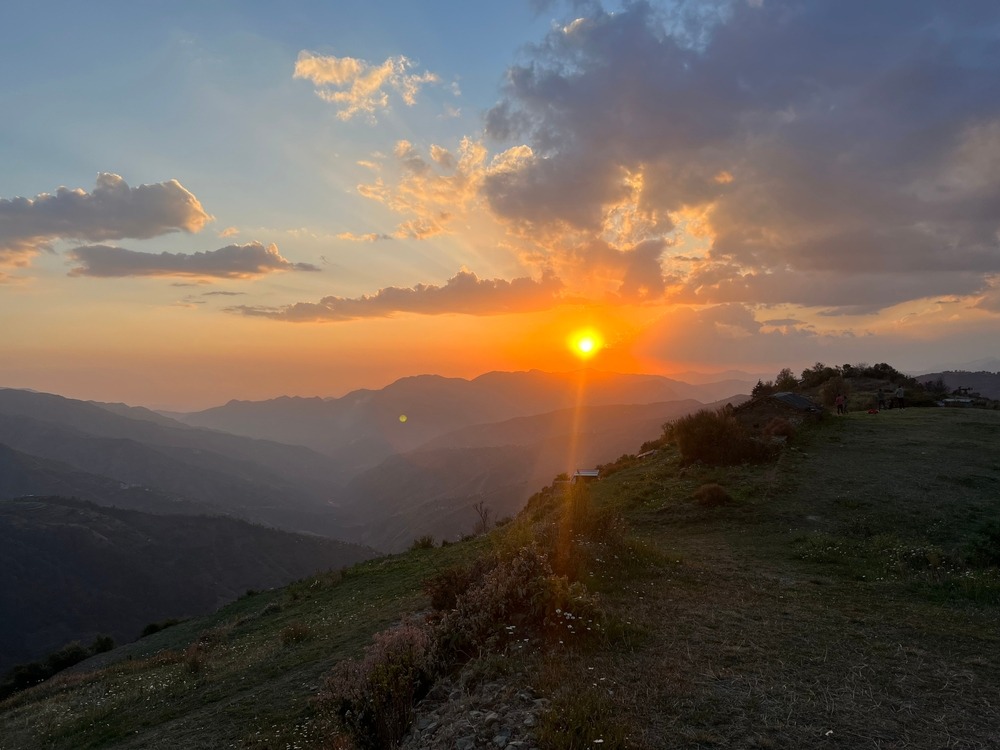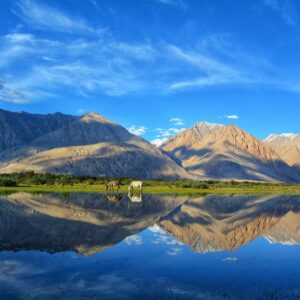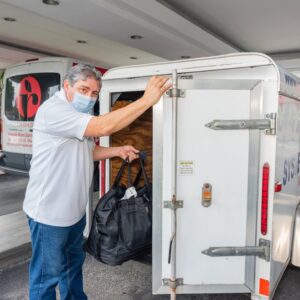Let’s not waste time—yes, Nag Tibba is 100% doable in a weekend, and if you’re craving the mountains but can’t take a week off, this trek is your perfect match. I’ve done it myself, and it’s probably the most satisfying weekend adventure you can have from Delhi or Dehradun.
Why Nag Tibba Works for a Weekend Trek

Think of it like this: you leave Friday night, hike on Saturday, summit Sunday morning, and you’re back home by late Sunday or early Monday. It’s a neat, quick escape that doesn’t need a long itinerary or expensive gear.
The trail is beginner-friendly and still delivers epic Himalayan views. You get everything—forest trails, snow (in winter), local village life, and that feeling of standing on a summit—all without needing a week of leave or intense training.
I went for nagtibba trek with a group organized by The Searching Souls. They kept it smooth, from pickups to meals to guiding on the trail. It felt like everything was taken care of, but in a way that didn’t feel overly packaged. You can just focus on walking and soaking it all in.
Where is Nag Tibba and How to Reach?
Nag Tibba sits in the Garhwal region of Uttarakhand, near Mussoorie. The trek starts from Pantwari village, about 90 km from Dehradun. Getting there is easy:
-
From Delhi: Overnight bus or train to Dehradun (Shatabdi or Nanda Devi Express are great options).
-
From Dehradun: A 3-4 hour drive to Pantwari.
Once you reach Pantwari, your trek begins. No waiting around. The drive from Dehradun is typically organised if you’re travelling in a group.
The Itinerary You’ll Actually Follow
Day 1 (Saturday)
-
Reach Dehradun by early morning.
-
Drive to Pantwari, have breakfast.
-
Start trek (~4-5 km) to basecamp.
-
Reach by afternoon, rest, enjoy sunset, dinner, and stargazing at night.
Day 2 (Sunday)
-
Early morning start to summit (3-4 km).
-
Savour the views of Bandarpoonch, Swaragarohini, and other locations from 9,915 feet.
-
Descend to basecamp, quick lunch, continue down to Pantwari.
-
Drive back to Dehradun and catch a bus/train home.
It’s compact but surprisingly complete. You don’t feel rushed, yet you get the full mountain vibe.
How Tough is the Trek?
It’s not Everest, but it’s no walk in the park either.
-
Difficulty: Easy to moderate
-
Distance: About 8–10 km one way
-
Max Altitude: 9,915 ft
You’ll feel the climb, especially if you’re not used to trekking, but it’s very doable. The trail alternates between open meadows, wooded pathways, and steep parts. Take breaks, sip water, and keep going.
If you’re decently fit (can walk 5-6 km on level ground), you can do this trek. And winter adds that extra punch—walking on snow is tough, but also insanely beautiful.
What Should You Pack?
Here’s the no-fluff list of essentials:
-
Good trekking shoes (ankle-high if you’re going in snow)
-
Jacket, fleece, thermals (layers work best)
-
Gloves, woolen cap, sunglasses
-
30-40L backpack
-
Water bottles (2L), energy bars
-
Toiletries, toilet paper, torch/headlamp
-
Extra pair of socks and undergarments
-
Raincoat (if going in shoulder seasons)
Most groups provide tents, sleeping bags, and mats. Check with them beforehand. I had all my gear handled by The Searching Souls, which helped a lot—especially when packing light.
When’s the Best Time to Go?

You’ve got two perfect windows:
-
Winter (Dec to March): Snow, magical landscapes, cold nights. My personal favorite.
-
Spring/Summer (April to June): Mild weather, blooming forests, clear skies.
Avoid monsoon (July to September). Landslides and slippery trails are not worth risking a weekend over.
What About Food and Stay?
At basecamp, you stay in tents. Nothing fancy—just you, your sleeping bag, and the mountains. And it’s honestly the best sleep you’ll have in ages.
Food is warm, simple, and hits the spot. Most groups serve dal, rice, sabzi, roti—basic Indian food that feels like a feast after the hike. You also get tea and snacks in the evening. And yes, you’ll crave Maggi at some point—it’s part of the experience.
Drinking water is usually filtered or boiled. Bring purification tablets just in case, but I didn’t need to use mine.
Is It Worth It?
One hundred percent. For a short weekend, Nag Tibba gives you:
-
A real summit experience
-
Mind-blowing Himalayan views
-
Peace, nature, and some silence for your brain
-
A break from city life without emptying your wallet
It’s short, sweet, and hits every high note of a Himalayan adventure.
Final Word
If you’re sitting on the fence about planning a weekend trek, stop overthinking. Nag Tibba delivers more than it promises, and it does it without asking for a single day of office leave. Just pack your bag, book your slot, and go. The mountains are waiting—and they’ve got hot chai and a view with your name on it.
FAQs
1. Is Nag Tibba safe for solo trekkers?
Yes, but going with a group (like The Searching Souls) ensures you don’t worry about directions or logistics.
2. Can beginners do Nag Tibba?
Absolutely. It’s one of the best beginner treks in India with a proper summit feel.
3. Is there mobile network during the trek?
You’ll get patchy network at Pantwari but likely none at basecamp or summit. Enjoy the digital detox.
4. Do I need a guide?
Highly recommended, especially if you’re new to trekking. Group organizers handle safety and navigation.
5. What’s the cost of the trek?
Around ₹2,500–₹4,000 if you go with a group. It includes food, stay, guides, and transport from Dehradun.





